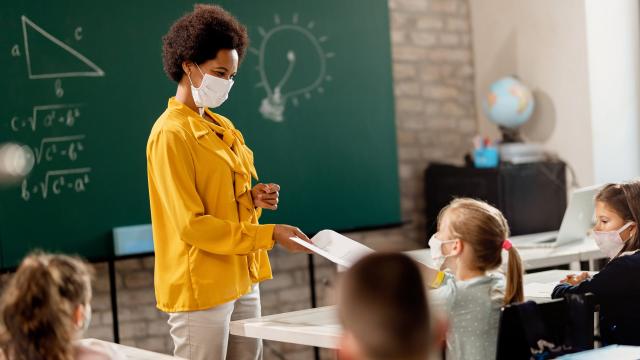“Mask-muffle” is a term I just made up, but it’s a real thing. If the cloth is meant to block a bunch of tiny respiratory droplets, it’s bound to muffle our words a bit, too. It can be hard enough to catch every word when you’re standing close to someone in a mask, and even more so if you’re the recommended six or more feet away. It doesn’t help that we’ve also lost the benefit of seeing a person’s mouth forming the words to fill in the blanks, which kids, in particular, rely on for speech and language development as well as social interactions.
You’re probably not wearing a mask super regularly when you’re hanging out with your own kids, but if you’re a teacher, a childcare provider, or you frequently interact with other children in masked-up situations, there are a few things you can do to communicate more clearly with them.
Talk like a kindergarten teacher
The best way to be heard by anyone, but especially by kids, is to start by slooooowing down. If you rush through your words, they’ll be garbled by your mask. Speak slowly and deliberately. You can also focus on making your voice more expressive so kids are better able to interpret your tone. Your playful voice can be a little extra silly, your stern voice a bit more serious.
What I’m saying is: Talk like a kindergarten teacher talks, with their signature big, bright, enunciating voices that get through to even the most rambunctious of five year olds.
[referenced id=”986630″ url=”https://www.lifehacker.com.au/2020/09/keep-your-kids-mask-on-a-lanyard/” thumb=”https://www.gizmodo.com.au/wp-content/uploads/sites/4/2020/09/04/uiaktcwethue9v4cbo0k-300×169.jpg” title=”Keep Your Kid’s Mask on a Lanyard” excerpt=”Lanyards are often used to keep our most precious objects — keys, for example, or a whistle if you’re a coach or referee — safe and easily accessible. And there is nothing our kids need more now to keep safe and easily accessible than their masks. That’s why, especially if…”]
Name emotions more often
I’ve seen a few friends posting mask selfies on social media — usually with a caption that insists they are, in fact, smiling. Sometimes you can tell, sometimes you can’t. But unless a person’s eyes are crinkled up in a grin or glaring at you through narrowed slits, it can be challenging to interpret emotion through the eyes alone.
So like we do in photo captions, it can be helpful to be more intentional about naming our emotions — and asking our kids to name theirs. Dr. Perri Klass writes for the New York Times:
Sarah Gaither, an assistant professor of psychology and neuroscience at Duke University, said in an email, “With mask wearing now being required in most school settings, children and adults should start practicing being more explicitly verbal by stating their emotions out loud.” Children will get better at reading people’s eyes, she suggested, and at understanding emotional content from tone of voice.
But in addition, she wrote, “parents and teachers may also want to ask children more often what they are feeling as well.”
The masks actually give us a good reason to more frequently describe what we’re feeling, and encourage kids to do the same. The extra practice of identifying and naming emotions could actually help strengthen their emotional intelligence in the long run.
Use more physical cues
Now that your voice is more expressive and you’re naming emotions left and right, add in the rest of your body.
Point to things you’re talking about, gesture a little more widely, clap when you’re delighted, and arch those eyebrows a bit higher in surprise. Maybe you’ll look a bit like a stage actor performing for the audience members in the back row, but you’re more likely to get your point across if you ramp up the body language a bit.
Finally, don’t worry about it too much
Masks are not a great accessory in the quest to communicate with anyone, let alone kids. But as frustrating as it can be, and as much as we may worry that children are losing out on valuable visual cues behind those masks, it’s not forever and it’s not all the time. They lose those visual cues when they’re moving about in the world right now, but they still experience plenty of mask-free moments at home.
Dr. Eva Chen, a developmental psychologist and associate professor at the Hong Kong University of Science and Technology, told the Times there is no evidence that children from cultures with even more extensive face coverings are any worse at recognising faces or emotions:
While children typically pay attention to people’s mouths while they are talking, “it’s by far not the only cue children have to communicate and to learn,” she said, and referenced a 2012 study showing that children were able to read facial emotions just as well when a mask was added.
In other words, what they lose behind the mask, they’ll make up for in the eyes, tone of voice, and body language.
Meet the smartest parents on Earth! Join our parenting Facebook group.

Leave a Reply
You must be logged in to post a comment.